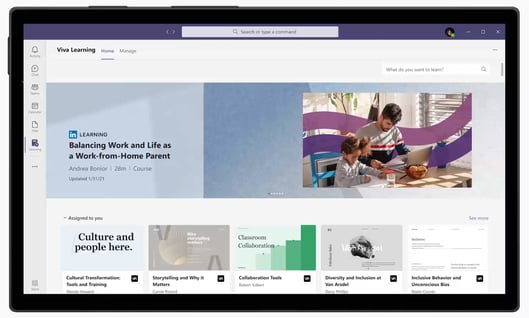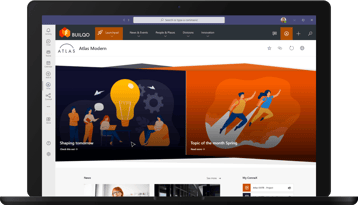Digital working practices are now a fundamental aspect of most people’s working lives. The reliance on intranets and digital workplace software has increased tremendously during the pandemic. The likes of Microsoft have seen a huge uptake of digital workplace software (Microsoft 365) as businesses look to technology to keep employees connected.
This technology facilitates communication and the sharing of information. It can enable people to get the information they need to carry out job roles and collaborate with each other. This functionalityhas led to many organisations revamping their Intranets. Today’s employees are settling into this new norm of remote/hybrid working and spending a significant proportion of time using digital workplace technologies such as an intranet. Employers are quickly realising that effective communication can only be achieved if employees are engaged. A major factor contributing towards high engagement is a positive employee experience.

As many organisations have tried to breathe new life into their intranets, they are finding that an out-of-the-box intranet solution simply won’t cut it. One size unfortunately does not fit all. Organisations need to carefully consider the needs of their employees and ensure that the digital tools they are implementing fulfill their needs. Factors such as usability, good design and familiarity all contribute towards high engagement levels and positive employee experience. Successful adoption of these factors ensures employees don’t feel overwhelmed when they are using a digital tool(s). High engagement can enhance company culture, and a sense of community can therefore still be fostered among employees.
The following points should be carefully considered by organisations looking to enhance employee experience and improve intranet engagement:
1. Make sure everyone has access
An intranet needs to be the go-to place where employees get information, insights, build relationships and share knowledge. These types of interactions are critical for building knowledge and maintaining a source of competitive advantage within a business. It is therefore crucial that everyone can partake in these activities and that no one gets left behind. People shouldn’t be restricted to access because of their working patterns. Especially in today’s working landscape. Remote, hybrid and front-line workers in different locations such as home, office, customer sites etc need to have access to information just as much as anyone else. The intranet needs to be available at any time and on any device. Factors such as a user’s ‘digital dexterity’ also needs to be considered, especially in terms of the intranet design.
2. Actively take on board employee feedback and use meaningful measurements
The focus of feedback is to make improvements. If your workforce can visibly see you are actively taking on what they say, this will drive engagement and improve employee experience. Employees who feel listened to and know they have a voice are more likely to contribute. Interactions should be meaningful. Always ensure that feedback is taken from a broad spectrum of employees: different job roles, functions, seniority levels and geographical locations. Feedback can be hosted on a variety of mediums such as running polls, surveys and user groups. This should be easily facilitated on an intranet.
Meaningful measurements: using analytics to measure things like adoption/usage rates, engagement, reach and user satisfaction is all well and good as long as the information gathered is used in a meaningful way and contributes towards informed decisions.
3. Coordination is key
An intranet is used to communicate a whole range of information and services. It’s often used for internal communications, knowledge management, collaboration, IT and HR self-service. The different areas need to be set out to the user in a logical and easy to navigate way. It cannot have the ‘feel’ of a dumping ground. Therefore, content needs to be added and maintained in a way that is structured and coordinated. There needs to be consistent involvement from a range of stakeholders including the SLA, HR, IT, Business Ops, Internal Comms etc. A coordinated effort makes for a better user experience. An intranet’s interface needs to be intuitive so that it can cater for the different types of users. It should easily integrate into the way they work, catering for their information needs and how they interact with technology.
4. Governance needs to be properly implemented
Content needs be relevant, current, within brand guidelines and consistent with company messaging for users to have a good experience. Consistency can be achieved by providing content owners with standardised, branded layouts and templates, implementing content tagging best practices and ensuring different users know exactly what parameters they can operate within. Having a proper order means that information can be easily found. Automation of tagging processes and other intranet housekeeping tasks means that content owners won’t be bogged down with trying to operate complex and time-consuming practices when they need to produce and maintain content. Self-service and the enablement of everyday users to update and contribute content is a critical aspect of a successful intranet. If you can’t easily contribute, then you’re less likely to be engaged. Making the process of contribution straightforward and manageable whilst also ensuring proper controls are in place can contribute to a system of high productivity and engagement with low risk.
5. Provide a seamless and personalised experience
With the rise of use of the digital workplace we are consistently seeing trends of people feeling overwhelmed. Information overload can lead to symptoms of a person feeling in constant panic (source Microsoft 2021 Work Trend Index Annual Report). A major contributing factor to this could be the sheer number of digital applications people have to use. According to a Pega report: employees switch between apps more than 1,100 times a day (techrepublic.com). Just as people get familiar with their digital environments, employers then introduce more digital applications and tools. Tech giants such as Microsoft have cottoned onto this and are now taking a conscientious approach to integrate their technology within the applications people use on a regular basis.
Make the experience personal. The 100 plus different apps used within your organisation are not applicable to everyone. Only a handful are applicable to any one given employee. Each employee should only receive content that is relevant to them, their department and geographical location. Departments tasked with reaching out to certain departments/individuals should also have the right tools to easily target items to specific users and groups. This helps them deliver effective messaging. This is much easier to achieve if the digital tools within an organisation are fully integrated. If the intranet has full integration with digital workplace then collaboration activities can take place in the apps employees use every day such as Teams.
This is Microsoft’s employee experience platform. It’s important to note that it’s not an additional platform that employees have to navigate. It has been developed to enable companies to enhance the experience of their existing intranets. Microsoft have coined ‘Microsoft Viva’ as an “organizing layer”. Microsoft’s CEO Satya Nadella believes that organisations need to unify their digital workplace experience for employees. An employee's experience should be holistic right the way through from the on-boarding process through to collaborating with colleagues and continuing education.
Viva is powered by Microsoft 365 and fully integrates within the tools that sit within it such as Microsoft Teams and Yammer.
Microsoft Viva is set out into 4 modules:
Over the p ast year or so many organisations have realised that an out-of-the-box intranet solution is unable to fully support high volumes of employees working remotely or now shifting to hybrid working practices.
ast year or so many organisations have realised that an out-of-the-box intranet solution is unable to fully support high volumes of employees working remotely or now shifting to hybrid working practices.
Atlas fully integrates with Microsoft Viva and Microsoft 365 to bring about a holistic and seamless user experience. It is the glue that brings all Microsoft tools together through a visually engaging and intuitive interface. This makes user interactions logical and easy to navigate.
It is the only digital workplace product to provide an end-to-end experience within Microsoft 365.
Why Atlas?
Our experience shows that our clients that have a fully integrated digital workplace have achieved considerable savings in both in time and money. A positive employee experience of using a fully integrated system means that employees can easily carry out their roles with minimal stress and overwhelm. Click here to find out from our customers have to say.
Subscribe to our newsletter
This site is protected by reCAPTCHA and the Google Privacy Policy and Terms of Service apply.